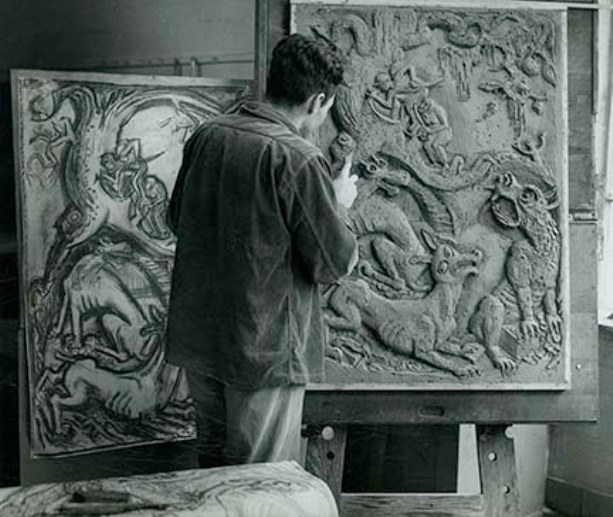By Nancy Finlay
In 1950, a young art student named Elbert Weinberg offered to create a sculpture for the Albany Avenue branch of the Hartford Public Library, then under construction. The decorative terra-cotta panel that he created illustrated “The Tinder Box,” a fairy tale by Hans Christian Andersen in which three gigantic dogs help a poor soldier to overcome his enemies and marry a beautiful princess.
Dogs and brides figure prominently in Weinberg’s work, most of it cast in bronze or carved in marble using age-old techniques. Born in Hartford in 1928, the future sculptor attended Weaver High School and began taking art classes at Hartford Art School even before he graduated. He received a traditional training in the arts at the Rhode Island School of Design and Yale, and in 1951 won the prestigious Rome Prize, which enabled him to continue his education in Italy like generations of artists before him.
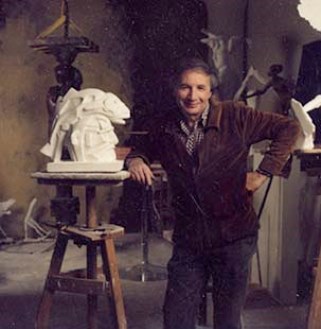
Elbert Weinberg in his Hartford studio, ca. 1990 – Hartford History Center, Hartford Public Library
For the next 25 years, Weinberg lived and worked primarily in Rome, creating sculptures of biblical and mythological figures that were enthusiastically received when he exhibited them in the United States. The Wadsworth Atheneum, the Museum of Modern Art, the Whitney Museum of American Art, and the Yale University Art Gallery all purchased major sculptures during the 1950s. His powerful liturgical works were acquired by synagogues throughout the country, including Temple Beth El, in West Hartford, where his monumental Procession of rabbis bearing ceremonial objects marches across the lawn facing Albany Avenue.
Weinberg and Abstract Expressionism
The art world changed in profound and dramatic ways in the mid-20th century, its focus shifting from Paris and Rome to New York City, where a group of young artists forged a new style known as abstract expressionism. Weinberg was well aware of contemporary trends, and as early as the 1960s, began experimenting with more abstract compositions. His “Brides” pieces became increasingly stylized, sometimes recognizable only by their titles. His Holocaust Memorial in Wilmington, Delaware, one of his most important public works, combines realistic human figures cast in bronze, representing the Jews of Europe, struggling against huge concrete forms symbolizing the Fascist government that persecuted them. In a second Holocaust monument, created for the Greater Hartford Jewish Community Center and cast in corten steel, a gigantic pair of arms holding aloft a shofar (a ceremonial ram’s horn) assumes the shape of the Hebrew letter “chai,” symbolizing “life.”
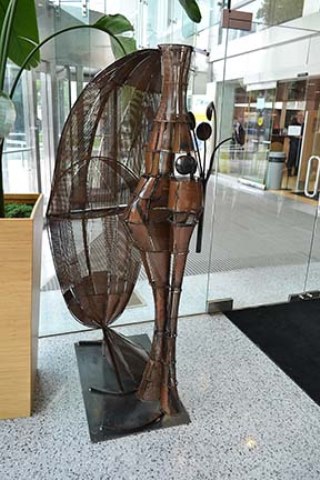
Metal Bride, metal statue by Elbert Weinberg on view in The Kitchen at the Hartford Public Library – Photograph by Pramod Pradhan, Hartford History Center, Hartford Public Library
Weinberg returned to the United States in 1976, and continued to create both figurative and non-figure sculptures, in an attempt to find a style that appealed to contemporary critics and audiences. He experimented with non-traditional materials, including stainless steel, sandblast, and terra-cotta, sometimes employing these materials in combination with bronze or marble.
Connecticut Sculptures
While working in a studio in the Colt Building in Hartford, he produced a series of figures fashioned from the reeds that grew along the Connecticut River, which Colt’s workers used to make furniture during the 19th century. He also continued to pursue commissions for large public sculptures, taking part in competitions throughout the United States.
The city of Hartford acquired one of his abstract stainless steel constructions in 1988, but officials were unable to agree on a location for it. Sites considered included the sidewalk in front of the Hartford Public Library, the Old State House, and various Hartford Parks. It was only after Weinberg’s death in 1991 that officials decided to install the sculpture, popularly known as Pickles and Palm Trees, on the corner of Capitol Avenue and Broad Street, near the Connecticut State Armory.
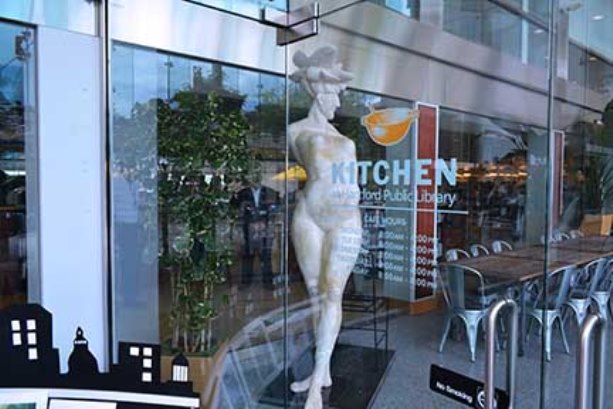
Demeter, plaster statue by Elbert Weinberg, on view in The Kitchen at the Hartford Public Library – Photograph by Pramod Pradhan, Hartford History Center, Hartford Public Library
Weinberg left an important legacy to Connecticut, including large public sculptures in Hartford and West Hartford, several works in Connecticut museums, and hundreds of letters, drawings, prints, and photographs donated to the Hartford History Center in the Hartford Public Library by the Weinberg Trust in 2014. Sculptures by Weinberg on permanent display in the library include Demeter, an eight-foot-tall plaster woman who greets visitors to The Kitchen, the Hartford Public Library café; Julia, a touching small bust of a little girl, Weinberg’s daughter; Metal Bride, recognizable by her veil and the bunch of flowers that she holds; Homage to Ivan Mestrovic, a monumental head made of reeds; and Picasso-Athena, the Bright-Eyed Goddess, a stylized combination of marble and steel.
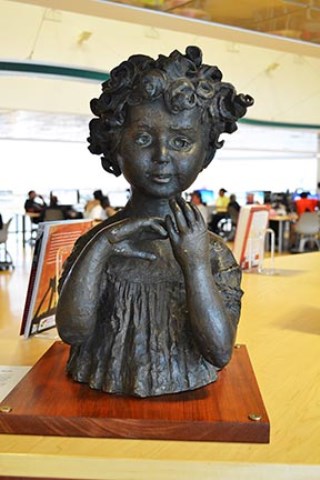
Julia, bronze statue by Elbert Weinberg, on view in the lobby of the Hartford Public Library – Photograph by Pramod Pradhan, Hartford History Center, Hartford Public Library
Nancy Finlay grew up in Manchester, Connecticut. She has a BA from Smith College and an MFA and PhD from Princeton University. From 1998 to 2015, she was Curator of Graphics at the Connecticut Historical Society.





